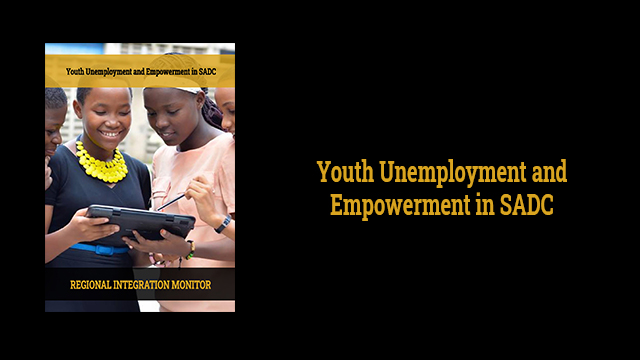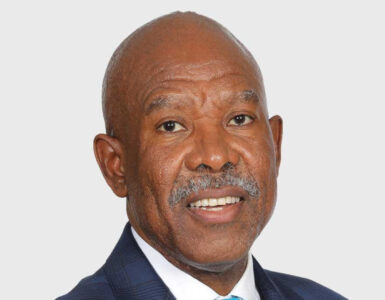Industry Spotlight: Youth Empowerment
African countries continue facing the challenge of high unemployment rates and fast-growing populations. SADC is not isolated from this challenge even though the average population growth rate remained at 2.6% from 2010 to 2015; compared to the average GDP growth rate which declined from 3.8% from 2010 to 2015, to 1.4% in 2016[25]. This is largely caused by the very young SADC population with a median age of 21.7 years and the sustained slow GDP growth which have resulted in high growth rates and worse employment prospects. The average unemployment rate in SADC was 10.7% in 2018, compared to the average unemployment rate of 5.9% in the rest of Sub-Saharan Africa[26]. These gloomy economic prospects are even worse when it comes the SADC youth. The average youth unemployment rate in SADC was 20.9% in 2018 compared to the Sub-Saharan Africa average of 9.8%[27]. SADC governments have recognised the importance of the youth population in regional development and the direct challenges faced by youth. That is why SADC countries have been striving to establish policies and programmes aimed at addressing youth unemployment.At continental and regional level, SADC cooperation can be extended with the African Union, Heads of States and Government in the adoption of frameworks to address youth employment which includes the African Youth Charter (AYC), with the Decade Plan of Action as a roadmap toward achieving the AYC, the 2016 SADC Youth Employment Promotion Policy Framework and labour Protocol. Besides that, there are also other many international development partners such as German Government, United Nation entities who are working together on youth issues in Africa and SADC countries providing technical assistance – cooperation projects (e.g., skills development, technical and vocational education, entrepreneurship development support, capacity building to foster regional integration agenda and ultimately reduce youth unemployment, etc.)[28].
Across from SADC countries, youth unemployment rates are recorded such as in Malawi under 5.0%, Zambia and Zimbabwe above 20.0%, Botswana, Namibia, Eswatini (formerly known as Swaziland), Lesotho, and South Africa above 30.0%[29]. The broad unemployment figures at SADC level raises the concern whether these youth policies and programmes have been significant in reduce youth unemployment and translated into securing decent employment opportunities in the respective countries. This can be attributed to the insufficient data and accuracy of information on the number of jobs created, and lack of system of monitoring and evaluation which makes difficult to assess the success and failure of the different youth policies and programmes[30].
Some of the key issues that SADC countries attempt to address in relation to youth employment are: poor skills development, sector-specific vocational and technical education, and lack of youth entrepreneurship skills[31]. These are usually aimed at resolving skills mismatch, low literacy and training. However, examples will be drawn from some selected SADC countries such as Botswana, Eswatini, South Africa and Namibia to illustrate where some initiatives were taken in terms youth development programmes which can be considered successful than other. Member States of SADC such as, Eswatini, and Botswana have managed to establish similar youth funds and National Internship programme. For instance, the Youth Entrepreneur Fund and Graduates Enterprise Programme in eSwatini, and the Youth Development Fund (YED) and National Internship Programme (NIP) in Botswana. Both of these programmes, the youth development fund aimed at addressing unemployment among youth providing money to young unemployed people to start business, while the National Internship Programme aimed at addressing the issue of skills development of the youth which involves placement of unemployed graduates in government and private sector organisations[32].
For example, In Botswana, the NIP managed to place around 3750 youth graduates in jobs in either government, parastatals, NGOs, or in the private sector for up to 24 months since its inception in 2009[33]. In eSwatini, since the inception of the YED in 2008, in year 2011 – 2012 reported, a total of 590 people received USD 718,000.0 and later, 152 people benefited from a total of USD 250,000.0 due to government budget constraints[34]. The Targeted Intervention Programme for Employment and Economic Growth (TIPEEG) in Namibia had created a total of 21,000 permanent jobs, 80,000 temporary jobs, and other indirect employment opportunities since its inception in 2011[35]. Although, the TIPEEG was not traditional solely focused on youth, it provided business opportunities for youth beyond employment, self-employment opportunities, and young-owned business[36].
In South Africa, the National Youth Development Agency (NYDA) has been established to design, coordinate, evaluate, monitor and integrate all youth development programme to address the youth socioeconomic issues at the national, provincial and local level[37]. The NYDA also provides grant funding to youth business (e.g., a total of 874 youth owned enterprises received grant funding and 4,071 jobs were created through grants programme)[38]. South Africa, in response to youth unemployment, introduced the Employment Tax Incentive (ETI) in 2014 to address the issues of reducing the cost of employing inexperience young workers, who are often viewed being more costly to hire due to training requirements, and whose productivity in relation to their wages, encourage young work seekers to look for employment[39]. The ETI was set to create 463,000 new jobs, however, there has been mixed results in terms of overall job creation for youth[40]. In 2018, the Youth Employment Services was launched as an incentive to private sector (business) to employ young people and provide youth with first work experience[41]. Since its inception, a total of 248 companies joined and 4600 youth had already found job placements. The aim of this initiative is to create one million jobs opportunities.
Despite the number of programmes aimed at reducing youth unemployment, and the achievements mentioned above, youth empowerment in SADC is still overly focused on work readiness, capacity-building and training. The SADC youth empowerment programmes are not discerning in terms of the gendered aspects of youth unemployment, which makes polices insensitive to the unequal impacts and causes of youth underemployment. In addition, there have been little financial support in the form of seed or venture-capital funding for youth entrepreneurship. There is not SADC equivalent of Silicone Valley or other ecosystems aimed at supporting youth-owned start-up. Lastly, there are no programmes aimed at political inclusion of youth in SADC. SADC youth are under-represented in SADC political systems at both regional and national level as evidenced by the low representation in all levels of governance[42]. Zimbabwe had the highest number of young people in a single or lower house of parliament at 3.0% of the house aged under 30, followed by South Africa with 2.8% of the members of its single and lower houses of parliament under 30 years, and Zambia with 0.6%[43]. The SADC Parliamentary Forum Youth Development Programme aims to encourage youth to increase their participation in politics, government, and other legislative structures[44].
Regardless of all the youth development policies and programmes in SADC, the youth continue to face unequal social, economic and political barriers. These barriers prevent young people from reaching their full potential and contributing effectively to sustainable development and deeper integration in the SADC region[45]. Consequently, there is a need to ensure that the relevant policies and programmes respond to the aspiration of young people and address the critical constraints they face. This requires a certain level of coordination and collaboration to stimulate both employment and expand the economic participation of youth beyond the labour market. Moreover, the policies and programme need to include effective monitoring and evaluation implementation in order to ensure the achievement of positive results and empowerment of youth.
By Serge Hadisi
[25] ILO 2019b. Statistics and Databases, International Labour Organisation: Geneva. Available At: https://www.ilo.org/ [Last Accessed: 10 May 2019].
[26] ILO 2018. World Employment and Social Outlook: Trends 2018, International Labour Organisation: Geneva. Available At: https://www.ilo.org/ [Last Accessed: 10 May 2019]; ILO 2019. Statistics and Databases, ibid.
[27] ILO 2019b. Statistics and Databases, ibid.
[28] Pharatlhatlhe, K. & Byiers, B. 2019. Youth Unemployment and the Role of Regional Organisations: The Case of the Southern African Development Community, European Centre for Development Policy Management: Maastricht. Available At: https://ecdpm.org/ [Last Accessed: 7 June 2019]; UN 2010. Regional Overview: Youth in Africa, United Nations: New York. Available At: https://social.un.org/ [Last Accessed: 6 June 2019]; ILO 2019c. Youth Employment in Africa, on the International Labour Organisation Website, viewed on 6 June 2019, from https://www.ilo.org/.
[29] UN 2010. Regional Overview: Youth in Africa, ibid.
[30] Pharatlhatlhe, K. & Byiers, B. 2019. Youth Unemployment and the Role of Regional Organisations. The Case of the Southern African Development Community, ibid; Nthomang, K. & Diraditsile, K. 2016. ‘Improving Youth Employment in Botswana: The Need for Evidence Based Policy and Programme Development’, Mosenodi Journal, Vol. 19, No. 1, pp.: 45-55.
[31] SADCPF 2017. Establishment of Youth Development Programme at Southern African Development Community Parliamentary Forum: 5-Year Strategic Plan (2017 – 2022), Southern African Development Community Parliamentary Forum: Windhoek. Available At: https://www.sadcpf.org/ [Last Accessed: 16 April 2019].
[32] Nthomang, K. & Diraditsile, K. 2016. ‘Improving Youth Employment in Botswana: The Need for Evidence Based Policy and Programme Development’, ibid.
[33] Nthomang, K. & Diraditsile, K. 2016. ‘Improving Youth Employment in Botswana: The Need for Evidence Based Policy and Programme Development’, ibid.
[34] Phakathi, M. 2011. Swaziland: Small-Loans for Young Entrepreneurs to Help Fight Crisis, on the Inter Press Service New Agency Website, viewed on 5 June 2019, from http://www.ipsnews.net/.
[35] ACBF 2017. Youth Unemployment in Africa: Capacity Building and Innovative Strategies, African Capacity Building Foundation: Harare. Available At: https://elibrary.acbfpact.org/ [Last Accessed: 11 June 2019].
[36] ACBF 2017. Youth Unemployment in Africa: Capacity Building and Innovative Strategies, ibid.
[37] ACBF 2017. Youth Unemployment in Africa: Capacity Building and Innovative Strategies, ibid.
[38] Pharatlhatlhe, K. & Byiers, B. 2019. Youth Unemployment and the Role of Regional Organisations. The Case of the Southern African Development Community, ibid.; NYDA 2018. Annual Report 2017-2018, National Youth Development Agency: Johannesburg. Available At: http://www.nyda.gov.za/ [Last Accessed: 11 June 2019].
[39] De Lannoy, A., Graham, l., Patel, L., & Leibbrandt, M. 2018. What Drives Youth Unemployment and What Interventions Help?: A Systematic Overview of the Evidence and a Theory of Change, University of Johannesburg: Johannesburg. Available At: https://www.uj.ac.za/ [Last Accessed: 26 May 2019].
[40] De Lannoy, A. et al. 2018. What Drives Youth Unemployment and What Interventions Help?: A Systematic Overview of the Evidence and a Theory of Change, ibid.
[41] Pharatlhatlhe, K. & Byiers, B. 2019. Youth Unemployment and the Role of Regional Organisations. The Case of the Southern African Development Community, ibid.
[42] UNHCR 2017. Africa’s Youth and Prospects for Inclusive Development: Regional Situation Analysis Report, United Nations High Commissioner for Refugees: Geneva. Available At: https://www.ohchr.org/ [Last Accessed: 16 April 2019]; IPU 2016. Youth Participation in National Parliaments, Inter-Parliamentary Union: Geneva. Available At: https://www.ipu.org/ [Last Accessed: 16 April 2019].
[43] UNHCR 2017. Africa’s Youth and Prospects for Inclusive Development: Regional Situation Analysis Report, ibid.; IPU 2016. Youth Participation in National Parliaments, ibid.
[44] SADCPF 2017. Establishment of Youth Development Programme at Southern African Development Community Parliamentary Forum: 5-Year Strategic Plan (2017 – 2022), ibid; UNHCR 2017. Africa’s Youth and Prospects for Inclusive Development: Regional Situation Analysis Report, ibid.
[45] SADC 2019. SADC Executive Secretary Calls for Youth-Focused Programmes at 17th Africa Scout Conference in Harare, on the Southern African Development Community Website, viewed on 16 April 2019, from https://www.sadc.int/.





























